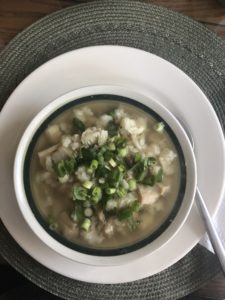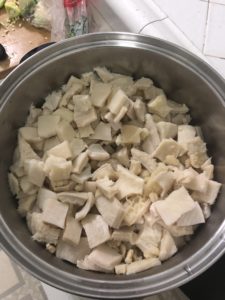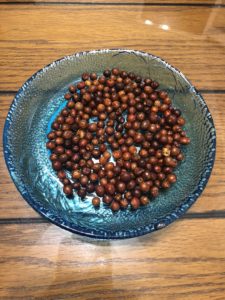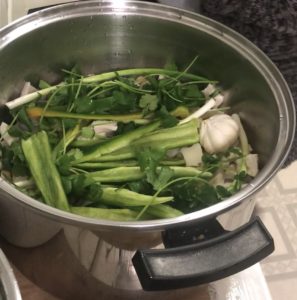
My grandmother was born in the state of Sinaloa, Mexico, where she was raised. During her childhood years she was taught how to cook and clean. My grandmother was very finicky in her ways. She had never eaten from someone else’s plate or spoon, and she never drank from someone else’s cup. My grandmother did not come from a rich family, but many thought she did come from a higher class in Mexico because of the way she would conduct herself. Others from the same regions would eat and share because they were hungry and poor.
As she got older she would go out and dance. My grandmother loved to dance and go to the events that were held nearby where she lived. One day she went to a dance and she met my grandfather. She was already 28, considered an older young lady in her town, and they would always ask my great grandmother what was wrong with my grandmother because she had not gotten married nor had become a nun. They used to say back in the day that if young women did not marry by the age of 16, they would become a nun or they would never get married. My grandmother never cared what the town people would say; she continued to live her happy life. My grandfather on the other had was 10 years younger than my grandmother and he was so in love with her that he wanted to marry her. My grandmother would tell him no because he was so young.
My grandmother continued to go out to the fiesta of the town. After a year, my grandfather asked her to marry him again. My grandmother again responded with “no you’re too young.” My grandfather said age is just a number. My grandfather said, “I will give you six months to think about marrying me.” The sixth month came and my grandmother said, “ok I’ll marry you in six months, but don’t say anything to anyone.” She figured it would buy her time so that she would not marry him. The 6 months came and my grandfather said “I’m here. Now will be married.” My grandmother then told him to give her another 3 months to prepare her parents for the news. My grandmother extended her wedding for almost 3 years. The last time my grandfather asked to marry her and he saw that she was going to give him other excuse he got his pocket knife and put it in her neck and said, “you will be my wife today” and saddled her up in the horse. My grandmother was married for 75 years.
At her wedding they had Menudo Blanco with beef legs in it. My grandmother was so sad because one, she had to get married because my grandfather took her, and two because she hated menudo because of the smell. I remember her always saying you need to clean the menudo very well to remove the smell. My grandmother would eat the menudo she would cook only because she would say “I don’t know how they cleaned it; maybe they did not clean it right.” She was very picky with the food she ate and the people who would cook it. She did not like to try new dishes from family members or a restaurant. She would say she would rather make the dish herself. My grandmother is the one who showed my mother and aunt how to clean the tripe very well before cooking it. She would add nixtamal, which is corn, to the menudo. She also had a method of cleaning the nixtamal, which was cut fresh. Now it is sold prepared and ready to cook. My grandmother lived up to the age of 103 years, and until her last day she would cook Menudo Blanco all by herself. She would not let my mother or aunt help her with the soup. They were only allowed to cut the vegetable that would go with the menudo.
Menudo is a dish that is eaten in many region of Mexico. The dish is prepared for weddings, engagements, birthday parties and posadas. The dish is very popular for special occasions. Menudo can be found almost everywhere in Mexico. You can find it in almost every state and many of their local restaurants. Many restaurants cook menudo on the weekend only when they expect more people. In different part of Mexico, Menudo is prepared differently. “In northwest states such as Sinaloa and Sonora usually only the Blanco” (Menudo, 2018). In other states of Mexico such as Jalisco, it is prepared red with the red California peppers. Although both soups are prepared differently with different Chile, they both taste delicious. Menudo has been prepared for many years in Mexico. Mexico claims to be the first to name tripe soup menudo. Although it is not sure who invented the menudo soup, yet it has been around since the 1930’s. Every family in Mexico cooks menudo in a different way. Our family, who is from the Northwest states, enjoys cooking and eating Menudo Blanco with bread such as bolillo. This dish is made at any time for us. It does not need to be at a special occasion. Our family tends to make the soup when it is cold most of the time on a Sunday morning to enjoy a family meal. Many families like eating Menudo in the morning after going to church. Going to mass on Sundays and eating Menudo on most Sunday was part of our family culture. Our family would wake up early to go to mass at 7:00am. As we got older and had our families, we still attended mass but for our children who don’t understand Spanish we tend to go to a late mass such as 9:45am. For my family I can associate Catholic mass and menudo together on Sunday. In many case there are still families who continue with their family tradition of Mass and Menudo.

Hominy is the corn that is used in many places in Mexico. Hominy is used in many dishes such as menudo and pozole. Hominy is used in our family recipe of menudo just to add a different texture from the tripe. My grandmother would always tell us that making menudo and pozole when she was younger was a time-consuming process because they had to cut the hominy and clean it and let soak until it was good to remove from the corn. Nowadays the processing is done by companies. Some companies have their own techniques on how to clean Hominy for example in “modern commercial technique, the corn is boiled in diluted sodium hydroxide, and the hulls are removed by the combined action of rotating cylinders and running water” (Hominy,2018). This has made the processing even faster and easier for people compared to when it was done by hand. Hominy is a corn that has been in America for many years. It is said the Native Americans would grow their own corn and it was an important part of their own food supply. Corn was a food that was eaten with almost every meal.
Chile Piquin is a spicy pepper that is grown in Mexico. The chiles grow in two colors, red and green. Both kinds of the chile are very hot. The Chile Piquin is “10 times hotter than a jalapeno” (Pequin, 2018). The chile is used in many recipes from hot salsa bottled chile. The chile can be eaten fresh or dried. When the chile is dried, the chile can last longer than the fresh chile. My family loves chile and the chile piquin has been a chile that I have eat very carefully because it is very spicy. I remember one day my uncle scared us when he was choking on a little flake of the crush chile piquin that end being stuck in his throat. We kept giving him water, soda and beer, but nothing seem to work. He kept coughing nonstop until my grandmother told him to take a full spoon of menudo and see if it help. My uncle did take the full spoon of menudo and he still felt the sensation of the chile, but he had stop coughing. We always thought my grandmother was very knowledgeable because she always found a way to cure us from colds or anything that was wrong with us.

Bolillos is a bread that is known in the states of “Sinaloa they are called torcidos” (Bolillo, 2018) and in the state of “Sonora they are called birote.” (Bolillo, 2018) All my younger years I knew this bread as a torcido. As I grew and my aunt moved to Sonora, then we started calling the torcidos birote. I then learned from my coworker that they called it bolillo. At first when they would say let’s have some bolillo with beans and cheese, I did not know what they were talking about. I knew what beans and cheese was, but never bolillo. So when they final brought it to work, it was my birote that I love so much. I then told them it is not bolillo, it is birote or torcido for me. My coworker laughed and they said “that is a weird name to call the bread”. I enjoy bolillo so much that I even drink the Abuelita Hot Chocolate drink with bolillo because it tastes so delicious.

“Mexican Restaurant – Menudo
Top of Form
- Servings:
Bottom of Form
| Calories | 233 | Sodium | 1,661 mg |
| Total Fat | 5 g | Potassium | 599 mg |
| Saturated | 2 g | Total Carbs | 30 g |
| Polyunsaturated | 0 g | Dietary Fiber | 6 g |
| Monounsaturated | 0 g | Sugars | 5 g |
| Trans | 0 g | Protein | 18 g |
| Cholesterol | 89 mg | ||
| Vitamin A | 147% | Calcium | 12% |
| Vitamin C | 270% | Iron | 44% |
*Percent Daily Values are based on a 2000 calorie diet. Your daily values may be higher or lower depending on your calorie needs.” (Calories in Mexican Restaurants Menudo, 2018)
Menudo Blanco ingredients:
5 lb. of Beef Tripe
2 1b. raw un cooked Hominy
1 White Onion
1 whole clove of Garlic
4 stalks of Green Onion
3 whole California Green Chiles
A couple dash of Salt to your taste
A couple stems of Cilantro
A couple of dash of Oregano for serving
A few drops of fresh Lemon Juice per serving
A pinch of Pequin pepper (optional)
Process of cleaning the Menudo:
Tripe:
Place the tripe in a flat surface. Once it is flat, look at all the imperfection of the excess skin and peel it off until it is clean and smooth. Place the tripe under warm running water and add baking soda as you are scrubbing the tripe to clean it. Once the tripe is clean, then you place the tripe in a large bowl and add lemon and let it sit for about 1 hour. After the hour, boil the tripe for about ½ hour and remove the rest of the imperfection of excess skin. Once all the process is done, cut the tripe in small squares.
Hominy:
Sort Hominy to remove any partials. Clean Hominy by rising with cold water five to six times until clean.
Cutting process of the vegetables:
Cut only the tip of the green steam and the tip of the onion.
Peel the whole onion and cut in half.
Peel a medium garlic head
Cut the California Green Chile in 4 parts and take out the Chile seed.
Finely dice the cilantro finely and place it in a dish.
Finely dice the rest of the white onion. Place it in a bowl.
Crush Oregano
Cut lemon fourths and place in bowl.
Cooking process:
Place the clean hominy in a large pot. Follow with the beef tripe already cleaned and cut in small squares. Add the onion, garlic, green onions, cilantro and California Chile. Once all the food is placed in the pot, add water and place it on the stove on low and let it cook for about 6 hours.

Check the soup every hour to determine if more water needs to be added. If more water needs to be added, add hot water in the pot.
Topping:
When the Menudo is placed in the bowl, add onions, oregano, green onions and chile piquin to your preferred taste. The spicier the better for a hangover.
Reference:
Bolillo. (2018, March 01). Retrieved March 10, 2018, from
https://en.wikipedia.org/wiki/Bolillo
Calories in Mexican Restaurant Menudo. (n.d.). Retrieved March 10, 2018, from http://www.myfitnesspal.com/food/calories/mexican-restaurant-menudo-117898520
Hominy. (2013, June 10). Britannica, T. E. Hominy. Retrieved March 10, 2018, from https://www.britannica.com/topic/hominy
Menudo (soup). (2018, March 05). Retrieved March 10, 2018, from https://en.wikipedia.org/wiki/Menudo_%28soup%29
Pequin. (n.d.). Retrieved March 10, 2018, from

Lovely blog post. What a strong and amazing woman your grandmother was.